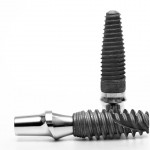
The use of dental implants has become relatively common and systematic reviews have shown good survival rates for a number of implant systems. However, there is a profusion of systems available with a range of surface modifications. The main aim of this review was to evaluate the long-term survival data of calcium phosphate-coated dental implants in clinical trials published between 2000 and 2011.
Searches were conducted in following databases National Library of Medicine, The Cochrane Central Register of Controlled Trials and the ISI Web of Knowledge. The searches were limited to human clinical trials in English published between 2000-2011. Screening and data abstraction was conducted independently by two reviewers disagreements being resolved by discussion.
- 5 studies were included (1 randomised controlled trial [RCT], 3 prospective and 1 retrospective study
- The estimated percentage of implants in function at 5 and 10 years was:-
- At 5 yrs; Maxilla 93.63% ( 95% CI; 92.1 – 95.1) Mandible 99.54% (95% CI; 99.54-99.54)
- At 10 yrs; Maxilla 89.7% ( 95% CI;87.5 – 91.5) Mandible 99.15% (95% CI; 99.15-99.15)
The authors concluded
….published long-term survival data for calcium phosphate-coated dental implants are very limited. Average percentage failure rates of calcium phosphate-coated dental implants do not increase progressively, and long-term cumulative survival rates for calcium phosphate-coated dental implants are comparable to survival rates of non-coated implants.
Comment
The authors’ restricted searches to after 2000 because of a review published by Lee et al (2000). However, although the inclusion criteria used for this review were similar to those used by Lee et al , the searches for the Lee review were restricted to a single database (Medline) so it is possible that they may have missed some studies. As with this current review only one of the 11 studies selected by Lee was an RCT and it is unclear whether the remaining studies were pro- or retrospective study designs. Overall Lee identified cumulative survival rates varying from 79.2-94.9% with 5-8 years of follow-up. While there may be some argument for restricting this latest review to the 11-year time fame selected, it does mean that not all the evidence available evidence is included within the review. It is also worth noting that all the studies designs were considered together ans some designs are more prone to bias.
The 2007 Cochrane review by Espositio et al looked at the difference in clinical performance of different types of dental implants. This review was restricted to randomised controlled trials of which 16 were included in the review. Their conclusion at the time was: –
There is limited evidence showing that implants with relatively smooth (turned) surfaces are less prone to lose bone due to chronic infection (perimplantitis) than implants with rougher surfaces. On the other hand, there is no evidence showing that any particular type of dental implant has superior long-term success. These findings are based on a few RCTs, often at high risk of bias, with few participants and relatively short follow-up periods.
Links
van Oirschot BA, Bronkhorst EM, van den Beucken JJ, Meijer GJ, Jansen JA, Junker R. Long-term survival of calcium phosphate-coated dental implants: a meta-analytical approach to the clinical literature. Clin Oral Implants Res. 2012 Nov 5. doi: 10.1111/clr.12063.
Lee, J., Rouhfar, L. & Beirne, O. (2000) Survival of hydroxylapatite-coated implants: A meta-analytic review. Journal of Oral and Maxillofacial Surgery 58: 1372–1379.
Esposito M, Murray-Curtis L, Grusovin MG, Coulthard P, Worthington HV. Interventions for replacing missing teeth: different types of dental implants. Cochrane Database of Systematic Reviews 2007, Issue 4. Art. No.: CD003815. DOI: 10.1002/14651858.CD003815.pub3.
